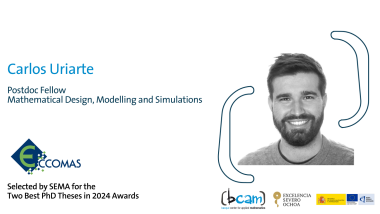- La defensa tendrá lugar en la Facultad de Ciencia y Tecnología de la Universidad del País Vasco, situada en el Campus de Leioa, a las 11:45 am
Gabriela Capo se incorporó al Basque Center for Applied Mathematics en 2015 como estudiante de doctorado (beca Predoc Severo Ochoa 2014). Tiene una Licenciatura en Ingeniería en Ciencias Aplicadas, obtenida en 2012 en la Universidad Politécnica de Bucarest, y un Máster en Modelado Matemático en Ingeniería del Programa Erasmus Mundus MathMods, un máster internacional de dos años otorgado conjuntamente por la Universidad de L'Aquila (Italia), la Universidad de Niza (Francia) y la Universidad de Hamburgo (Alemania).
Su tesis doctoral ha sido dirigida por el Prof. Luca Gerardo-Giorda, líder de la línea de investigación de BCAM en
Modelado Matemático para las Biociencias, y por Daniela Calvetti, Profesora de la Case Western Reserve University de Cleveland (EEUU). Durante su doctorado tuvo varias estancias cortas en los Estados Unidos, sumando un total de 6 meses, durante los cuales trabajó en estrecha colaboración con la profesora Daniela Calvetti y el profesor Erkki Somersalo, reconocidos expertos en modelado matemático del metabolismo cerebral.
En nombre de todos los miembros de BCAM queremos desear mucha suerte a Gabriela en la defensa de su tesis.
[idea]
Título: Computational predictive modeling of integrated cerebral metabolism, electrophysiology and hemodynamics
Understanding the energetic requirement of brain cells during resting state and during high neuronal activity is a very active research area where mathematical models have contributed significantly by providing a context for the interpretation of the experimental results. In this thesis, we present three new computational predictive mathematical models to elucidate several dynamics in the brain, comprising electrophysiological activity, cellular metabolism and hemodynamic response. Many computational challenges had to be addressed, mostly due to the very different characteristic times at which the electrical, metabolic and hemodynamic events occur. The first part of the thesis proposes a novel predictive mathematical electro-metabolic model connecting the electrophysiological activity and the metabolism through a double feedback mechanism based on energy demand and production. This model sheds light on the role of the glial potassium cleaning in brain energy metabolism by integrating a four compartment metabolic model with one describing in details the electrical activity. The results of computed experiments performed with this model for different protocols, namely awake resting state, transitions between resting state and neuronal activation and ischemic episodes are in agreement with experimental observations.
In the second part of the thesis, the electro-metabolic model is expanded to comprise the brain hemodynamic response. This is attained through a triple feedback mechanism between the electro-physiology, metabolism and a three compartment hemodynamic model tracking the changes of cere- bral blood flow and cerebral blood volume through arteries, capillaries and veins. During neuronal activation, the increase in extracellular potassium concentration triggers an increase in the cerebral blood flow and concurrently vasodilation, ensuring the supply of nutrients necessary for the metabolic response to sustain the increased energy demand. The ensuing hemo-electro-metabolic model provides a better insight on the transitions between resting state and neuronal activation.
In the third and last part of the thesis, we propose a variant of the electro-metabolic model that adequately describes the changes in the brain in connection with cortical spreading depression (CSD) waves. In addition the dynamics of sodium and potassium, the new model accounts for chloride dy- namics, the glutamate-glutamine cycle, as well as neuronal swelling accompanied by shrinkage of extracellular space. As illustrated with computed experiments, with this model it is possible to follow simultaneously the changes in ionic homeostasis, the alterations in the volumes of the cellular com- partments and of the extracellular space, and large modifications in brain metabolism during cortical spreading depression waves. The model predictions, in agreement with findings reported in the experi- mental literature, show a large decrease in glucose and oxygen concentration and a significant increase in lactate concentration during the passing of cortical spreading depression waves.
[/idea]




